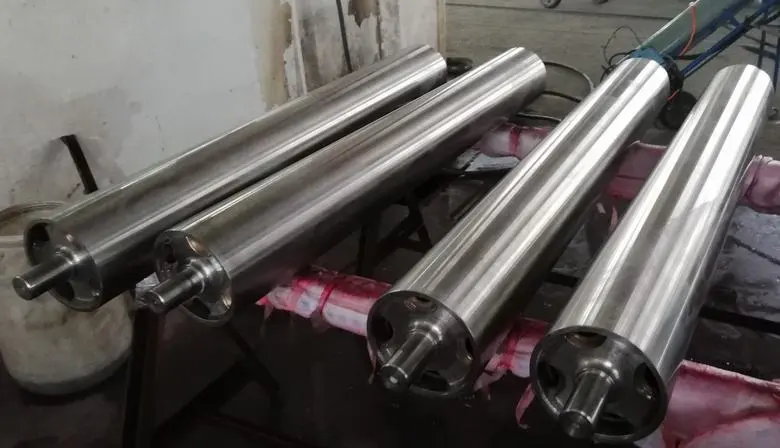The maintenance costs for stabilizer rolls can vary significantly depending on several factors, including the type of roll, its size, the operating environment, and the frequency of use. Generally, these costs can be categorized into routine maintenance, periodic overhauls, and unexpected repairs. Routine maintenance typically involves regular inspections, cleaning, and lubrication, which may cost between $500 to $2,000 annually, depending on the roll's size and complexity. Periodic overhauls, which might be necessary every 3-5 years, can range from $5,000 to $25,000 or more, depending on the extent of refurbishment required. Unexpected repairs due to accidents or premature wear can be the most costly, potentially reaching $50,000 or more for severe damage or complete replacement.
Factors Influencing Stabilizer Roll Maintenance Costs
Material and Construction
The material and construction of the stabilizer roll significantly impact its maintenance costs. Rolls made from high-quality materials like stainless steel or specialized alloys tend to have higher initial costs but often require less frequent maintenance and longer lifespans. For instance, a roll constructed from 316L stainless steel offers excellent corrosion resistance, reducing the need for protective coatings and frequent replacements in harsh environments. Conversely, rolls made from less durable materials may be cheaper upfront but could incur higher maintenance costs over time due to more frequent repairs or replacements.
Operating Environment
The environment in which the stabilizer roll operates plays a crucial role in determining maintenance costs. Rolls used in corrosive or high-temperature environments may require more frequent inspections and specialized maintenance procedures. For example, in the paper industry, where rolls are exposed to chemicals and high humidity, protective coatings may need to be reapplied more often, increasing maintenance expenses. Similarly, rolls used in the steel industry might face extreme temperatures, necessitating more frequent bearing replacements and surface treatments.
Operational Intensity
The intensity and duration of operation directly affect the maintenance needs of stabilizer rolls. Rolls used in continuous, high-speed production lines will naturally experience more wear and tear compared to those used in intermittent or low-speed applications. This increased stress can lead to more frequent bearing replacements, surface refinishing, and balancing procedures. For instance, a roll operating 24/7 in a high-speed textile production line might require maintenance checks every 3-6 months, while a similar roll used in a less demanding application might only need annual inspections.
Breakdown of Maintenance Procedures and Costs
Routine Inspections and Cleaning
Regular inspections and cleaning are fundamental to maintaining stabilizer rolls in optimal condition. These procedures typically involve visual examinations for signs of wear, damage, or misalignment, as well as cleaning to remove debris and contaminants that could affect performance. The cost for routine inspections and cleaning can range from $200 to $1,000 per roll, depending on its size and the complexity of the system it's part of. This preventive measure is crucial in identifying potential issues before they escalate into more serious and costly problems.
Lubrication and Bearing Maintenance
Proper lubrication is essential for the smooth operation of stabilizer rolls and the longevity of their bearings. Depending on the roll design and application, lubrication may need to be performed weekly, monthly, or quarterly. The cost of lubrication materials and labor can range from $100 to $500 per maintenance cycle. Bearing maintenance, including replacement when necessary, is a more significant expense. A complete bearing replacement for a large industrial stabilizer roll can cost between $2,000 to $10,000, including parts and labor.
Surface Refinishing and Balancing
Over time, the surface of stabilizer rolls can become worn or damaged, affecting their performance. Refinishing the roll surface to restore its smoothness and dimensional accuracy is a critical maintenance procedure. The cost of surface refinishing can vary widely, from $1,000 for minor resurfacing to $15,000 or more for complete refurbishment of large, specialized rolls. Additionally, balancing the roll after refinishing or as part of regular maintenance is crucial for optimal performance. Dynamic balancing procedures can cost between $500 to $3,000, depending on the roll's size and the precision required.
Strategies for Optimizing Maintenance Costs
Preventive Maintenance Programs
Implementing a robust preventive maintenance program is one of the most effective ways to optimize the maintenance costs of stabilizer rolls. This approach involves scheduled inspections, cleaning, and minor repairs to prevent major breakdowns. By addressing small issues before they escalate, companies can avoid costly emergency repairs and production downtime. A well-structured preventive maintenance program might include weekly visual inspections, monthly lubrication checks, and quarterly comprehensive assessments. While this proactive approach requires an initial investment in time and resources, it can significantly reduce long-term maintenance costs and extend the operational life of stabilizer rolls.
Condition Monitoring Technologies
Adopting advanced condition monitoring technologies can revolutionize stabilizer roll maintenance strategies. These technologies use sensors and data analytics to continuously monitor the performance and condition of rolls in real-time. Parameters such as vibration, temperature, and surface condition can be tracked, allowing for predictive maintenance based on actual equipment condition rather than fixed schedules. While the initial investment in these systems can be substantial, ranging from $10,000 to $50,000 depending on the complexity and scale of implementation, they can lead to significant cost savings over time by reducing unnecessary maintenance and preventing catastrophic failures.
Staff Training and Expertise Development
Investing in staff training and developing in-house expertise can substantially reduce the reliance on external maintenance services, thereby lowering overall costs. Properly trained technicians can perform routine maintenance tasks, conduct basic repairs, and accurately interpret condition monitoring data. This not only reduces the frequency of calling in specialized technicians but also ensures that maintenance is performed correctly and timely. The cost of comprehensive training programs for maintenance staff can range from $2,000 to $10,000 per person, but this investment can yield substantial returns through improved equipment reliability and reduced maintenance expenses.
In conclusion, understanding and managing the maintenance costs associated with stabilizer rolls is crucial for operational efficiency and cost-effectiveness in industries relying on these components. By considering factors such as material quality, operating conditions, and maintenance strategies, businesses can optimize their maintenance programs to balance costs with performance and longevity. Implementing preventive maintenance, leveraging condition monitoring technologies, and investing in staff training are key strategies for minimizing long-term maintenance expenses while ensuring the reliability and efficiency of stabilizer rolls in industrial processes. For more information on stabilizer rolls and expert advice on maintenance strategies, please contact us at info@welongpost.com.




